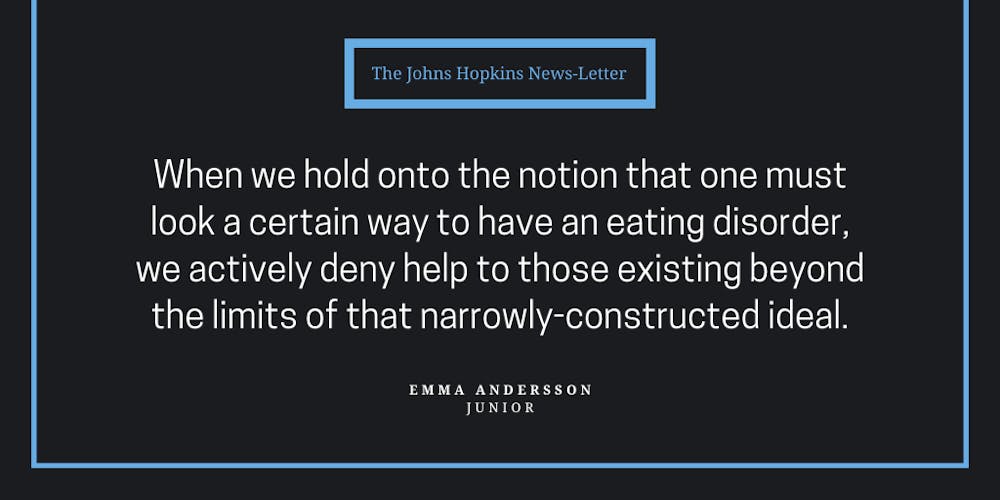Last week was the 39th annual Eating Disorders Awareness Week, a period devoted to sharing and reflecting upon lived experiences and eating disorder education. The week of awareness is one of many impactful initiatives spearheaded by the National Eating Disorders Association (NEDA), representing a time to advocate for those affected by eating and body image disorders. It is also a time to invite additional people into the conversation.
I admire the effort to support individuals and their families, to champion prevention programs and to fight for greater access to quality care. But after well-meaning (but often harmful) graphics have circulated on social media, I find it crucial to recognize where our society continues to fall short and to illustrate how we can do better.
The mainstream media and the medical community, through weight-based diagnosis criteria for certain disorders, produce and reproduce the stereotypical image of a person struggling with an eating disorder: she is a white, rail-thin, cisgender, heterosexual teenage girl. She battles anorexia, sometimes bulimia, and comes from a middle or upper class family. She longs to be beautiful and starves herself to the point of emaciation accordingly. (See Lily Collins’ character in Netflix’s To the Bone.)
Though that girl exists, she is far from representative of those who suffer from eating disorders — because there is no single representative for such a heterogeneous population. Eating and body image disorders touch people across all identities: BIPOC struggle with eating disorders; men struggle with eating disorders; those living with disabilities struggle with eating disorders; queer people struggle with eating disorders; overweight people struggle with eating disorders. The list goes on. So if we are going to talk about spreading awareness this week, we first need to expand the scope of who we are raising awareness for.
According to NEDA, an astounding 28.8 million Americans suffer from an eating disorder at some point during their lifetime, but it is critical to emphasize that Black and Hispanic teens exhibit a greater prevalence of disordered eating behavior than their white counterparts. Moreover, eating disorders cause the second highest mortality rate of all mental illnesses, and people of color are significantly less likely to receive help for eating issues in the U.S.
NEDA reports that its helpline has measured a 107% increase in activity since the onset of the COVID-19 pandemic, signaling an alarming trend that demands an immediate public health response. But in order to be productive, that response must engage with the aforementioned disparities in likelihood of diagnosis and access to treatment.
That means recognizing that eating disorders are not about appearance; they develop out of much larger processes of discrimination, exclusion and trauma. That means acknowledging that, in some cases, elements of identity actually render people more vulnerable to the onset of an eating or body image disorder. That means identifying and addressing the societal and systemic challenges preventing marginalized populations from accessing equitable treatment and leaving them less likely to recover.
The truth is eating disorders do not discriminate based on size, age, gender, sexuality, race or ethnicity — so why do we? When we hold onto the notion that one must look a certain way to have an eating disorder, we actively deny help to those existing beyond the limits of that narrowly constructed ideal. So if you want to participate in Eating Disorders Awareness Week in the future — and I encourage you to — please do so with this in mind.
Take care that the images or statistics posted to your social media do not propagate the dangerous misconception that only a specific physical type warrants advocacy. Seek out spokespeople from marginalized communities (shoutout to Roxane Gay and Kiese Laymon) and be mindful of the voices you choose to amplify. Social media is a powerful tool. Use it to lift up those that have historically been left behind.
As the statistics prove, the rise of eating and body image disorders is part of the ongoing mental health crisis and demands an informed response. Correcting the dominant practices and perceptions that unfairly determine who is and who is not worthy of support requires that advocacy work and media representation become more inclusive. But while that initiative begins with Eating Disorders Awareness Week, it does not end after day seven. I urge you to contemplate these inequalities in the weeks and months ahead because they will not change until mainstream attitudes do.
Emma Andersson is a junior from Madison, N.J. majoring in International Studies and Sociology.





